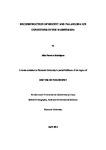Reconstruction of recent and palaeo sea ice conditions in the Barents Sea
| dc.contributor.supervisor | Belt, Simon | |
| dc.contributor.author | Navarro-Rodríguez, Alba | |
| dc.contributor.other | School of Geography, Earth and Environmental Sciences | en_US |
| dc.date.accessioned | 2014-08-13T09:19:15Z | |
| dc.date.available | 2014-08-13T09:19:15Z | |
| dc.date.issued | 2014 | |
| dc.date.issued | 2014 | |
| dc.identifier | 10251329 | en_US |
| dc.identifier.uri | http://hdl.handle.net/10026.1/3085 | |
| dc.description.abstract |
IP25 is a highly branched isoprenoid alkene derived from certain Arctic sea ice diatoms that, when detected in marine sediments, has been used as a proxy for past Arctic sea ice over the last decade. In the current study, the structure of this biomarker was determined following large-scale extraction from sediment material collected from the Canadian Arctic. After purification, the structure of IP25 was confirmed by NMR spectroscopy as being the same as that of a laboratory standard. The purified IP25 was subsequently used to obtain a quantitative (GC-MS) instrumental response factor that could be used to improve the future quantification of IP25 and would help to produce a robust database. IP25, other highly branched isoprenoid (HBI) lipids and some other phytoplanktonic lipids (sterols) were analysed to provide modern and past sediment-based sea ice reconstructions for the Barents Sea. First, a surface sediment study was conducted and biomarker distributions were compared to satellite sea ice records. The occurrence of IP25 was consistent with the presence/absence of seasonal sea ice but there was also evidence of lateral transport of IP25 and other biomarkers in sediments from the southern Barents Sea. In contrast to some previous studies, abundances of IP25, and of those combined with other biomarkers, including sterols, did not show strong quantitative relationships to sea ice concentration. The surface study was used to relate biomarker distributions to recent sea ice and oceanographic conditions and apply this information to long-term sediment records in the eastern and western Barents Sea covering ca. 2 kyr and 11 kyr (Holocene) respectively. IP25 concentrations for the former were found to be very variable and were used to identify the period with maximum sea ice cover occurring from ca. 900 - 400 cal. yr BP where the highest abundances of IP25 and IRD were observed. Similarly, biomarker results from the eastern Barents Sea provided evidence for a dynamic advance of the marginal sea ice zone potentially situated at ca. 78° N (maximum extent) during ca 9.4 – 5.9 cal. kyr BP, to late Holocene and modern day maximum MIZ advance ca. 75° N. Replicate analysis of various biomarkers in individual push-cores collected from a box core obtained from Rijpfjorden (north Svalbard) demonstrated some variability between cores. Variability in individual biomarker concentrations was lowest for HBI lipids and greatest for sterols. These data are consistent with a selective and relatively minor source of the former. In contrast, the somewhat more generic origins of sedimentary sterols likely explain the greater variability in their distributions between cores Finally, the strong abundance relationship between IP25 and a structurally related di-unsaturated HBI (C25:2) was confirmed in all sediments, similar to that found between two tri-unsaturated HBIs, consistent with co-production by certain marine phytoplankton. The progressive use of novel HBIs with two or three degrees of unsaturation (e.g. C25:2 and C25:3) could provide further valuable insights into environmental conditions. | en_US |
| dc.description.sponsorship | European Commission within the 7th Framework Program. Marie Curie Actions | en_US |
| dc.language.iso | en | en_US |
| dc.publisher | Plymouth University | en_US |
| dc.subject | Biomarker | |
| dc.subject | Sea ice | |
| dc.subject | Reconstructions | |
| dc.subject | North Atlantic | |
| dc.subject | Sediments | |
| dc.subject | GC-MS | |
| dc.subject | IP25 | en_US |
| dc.title | Reconstruction of recent and palaeo sea ice conditions in the Barents Sea | en_US |
| dc.type | Thesis | |
| plymouth.version | Full version | en_US |
| dc.identifier.doi | http://dx.doi.org/10.24382/4988 |
Files in this item
This item appears in the following Collection(s)
-
01 Research Theses Main Collection
Research Theses Main


